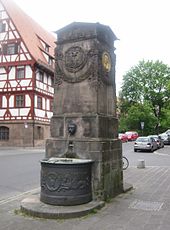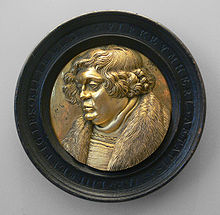Willibald Pirckheimer

Willibald Pirckheimer (also Bilibald Pirkheimer , Latin Bilibaldus ; * December 4, 1470 in Eichstätt , † December 22, 1530 in Nuremberg ) was a German Renaissance humanist , lawyer and translator, general, artist and art collector and patron. He was a friend of Albrecht Dürer and adviser to Emperor Maximilian I. From 1496 to 1523 he was a member of the Nuremberg Council (with interruptions).
Life
Willibald Pirckheimer was born in the prince-bishop's residence town of Eichstätt, where his father, the lawyer Johannes Pirckheimer , was the bishop's secretary. The Pirckheimer family, first mentioned in 1358, belonged to the Nuremberg patriciate since their first admission to the Inner Council of the free imperial city of Nuremberg in 1386 . In 1467 the father became a consultant (councilor) in Nuremberg. He and his wife Barbara Löffelholz had 12 children, seven of whom, in addition to Willibald, reached adulthood.
Willibald went through seven years of study in Italy, at the universities of Padua and Pavia . He was following a family tradition established by his great-uncle Thomas Pirckheimer , who was the first to study law and humanities in Italy. His older sister Caritas Pirckheimer was the abbess of the Nuremberg Clarakloster . Probably in 1495 he first met Albrecht Dürer.
He was a member of a circle of Nuremberg humanists, which also included Conrad Celtis , Sebald Schreyer (1446 to 1520) and Hartmann Schedel , the author of Schedel's world chronicle . He has translated numerous classical works into German and Greek works into Latin. In this context his publication of Ptolemy's Geographia in 1525 should be mentioned. Emperor Maximilian I consulted with him on literary issues.
In 1499, Pirckheimer was appointed by the Nuremberg magistrate to command the imperial city troop contingent in the Swabian War against the Confederates . In the Landgraviate of Klettgau , his troops plundered several villages, especially Rechberg . On his return he received a golden trophy. An allusion to this can possibly be found in Dürer's engraving Nemesis around 1502.
Since Dürer had no classical training, it is usually assumed that the numerous classical and humanistic allusions in his works go back to conversations with Pirckheimer; as an exception to this applies mainly Melencolia I . Pirckheimer lent Dürer the money for his second trip to Italy around 1506/1507, and ten letters from Dürer to Pirckheimer in Italy attest to their close friendship.
Pirckheimer's book collection was known beyond Nuremberg, as was his collection of all sorts of art objects (this collection was expanded by Willibald Imhoff , Pirckheimer's grandson, and served as the basis for Imhoff's art cabinet founded around 1545 ).
Pirckheimer was with Juliane Geuder , Martin III's sister. Geuder married at Neunhof . Like Dürer, Pirckheimer is buried in the St. Johannis cemetery in Nuremberg (grave St. Johannis I / 1414).
publicist
Pirckheimer got involved in the learned debates of his time. In particular, he stood up for Johannes Reuchlin in the Jewish book dispute and Martin Luther . He was probably the author of the satire Eccius Dedolatus (about: The planed corner) published in 1520 under the pseudonym “Joannes Franciscus Cottalambergius” , with which the Luther opponent Johannes Eck was mocked. In any case, Eck had him included in the papal bulls of excommunication of 1520 and 1521 against Luther and his followers. The Protestantism against Pirckheimer was set but rather critical.
Artist
Together with Johannes Stabius , he designed the allegorical framework for the “Triumphzug” and the “ Ehrenpforte Maximilian I ” (which Albrecht Dürer illustrated), in which the political concept of Maximilian I was propagated. Pirckheimer was also significantly involved in the design of the iconographic program for the Nuremberg town hall hall . Dürer, who was probably involved in the planning at an early stage, was responsible for the implementation from 1521 to 1522; the painting of the hall was not finished before 1528-1530.
Lawyer and appraiser
Willibald Pirckheimer played an outstanding role in the reception of Roman law in Germany. Gregor Haloander , a young scholar, had collected materials in Italy for the critical edition of Justinian's Pandects he was planning and had turned to the Nuremberg Council for assistance in carrying out this plan. A council commission asked Willibald Pirckheimer for an expert opinion in 1528, which turned out to be extremely favorable. This and the advocacy of the reformer Philipp Melanchthon meant that in 1529, with the support of the city of Nuremberg, Roman law could appear in the text edited by Gregor Haloander under the title Digestorum seu Pandectarum libri quinquaginta .
Pirckheimer in memory
- In Nuremberg there is a Pirckheimer Gymnasium and Pirckheimerstrasse in his honor.
- In 1821 the classicistic Dürer-Pirckheimer-Brunnen was erected in Nuremberg to commemorate both of them.
- Image on the 100 trillion Mark banknote dated February 15, 1924
- A Bibliophile Association, the Pirckheimer Society , founded in East Berlin in 1956 , was also named after him.
- In the 1960s, the Willibald Pirckheimer Medal was awarded for literary achievements.
- A bust of him is exhibited in the Hall of Fame in Munich .
- Of the portrait on the DM 50 banknote of the second series of the German mark (18 September 1951) was temporarily assumed it was a work of Dürer, show the Pirckheimer.
Editions and translations
- Emil Reicke, Helga Scheible (ed.): Willibald Pirckheimer's correspondence. (= Humanist letters. 4) 7 volumes. Beck, Munich 1940–2009 (critical edition; volumes 1 and 2 by Reicke, volumes 3–7 by Scheible).
- Niklas Holzberg (Ed.): Eckius dedolatus. The corner discovered. Reclam, Stuttgart 1983, ISBN 3-15-007993-4 (Latin text and translation).
- Wolfgang Schiel (Ed.): The Swiss War , translated from the Latin by Ernst Münch. Military publishing house of the German Democratic Republic, Berlin 1988, ISBN 978-3-85648-094-3 .
- Wolfgang Kirsch (ed.): Willibald Pirckheimer: Defense speech or self-praise of gout. Dingsda, Leipzig 2013, ISBN 978-3-928498-47-0 (Latin text and German translation).
literature

- Bernhard Ebneth: Willibald Pirckheimer. In: New German Biography (NDB). Volume 20, Duncker & Humblot, Berlin 2001, ISBN 3-428-00201-6 , p. 475 f. ( Digitized version ).
- Willehad Paul Eckert, Christoph von Imhoff: Willibald Pirckheimer. Dürer's friend in the mirror of his life, his works and his environment. 2nd, expanded edition. Wienand, Cologne 1982, ISBN 3-87909-109-9 .
- Joachim Gruber : Pirckheimer, Willibald. In: Manfred Landfester (ed.): Renaissance Humanism. Lexicon for the reception of antiquities (= Der Neue Pauly . Supplements. Volume 9). Metzler, Stuttgart / Weimar 2014, ISBN 978-3-476-02469-5 , Sp. 755-759.
- Niklas Holzberg : Willibald Pirckheimer. Greek humanism in Germany. Fink, Munich 1981, ISBN 3-7705-1889-6 .
- Klaus-Stefan Krieger: Willibald Pirckheimer. In: Biographisch-Bibliographisches Kirchenlexikon (BBKL). Volume 7, Bautz, Herzberg 1994, ISBN 3-88309-048-4 , Sp. 628-633.
Web links
- Literature by and about Willibald Pirckheimer in the catalog of the German National Library
- Works by and about Willibald Pirckheimer in the German Digital Library
- http://www.philological.bham.ac.uk/bibliography/p.html Proof of Latin works on the Internet
- http://www.pirckheimer-gesellschaft.de/html/will_car.html Short biography of Dieter Wuttke on the website of the Pirckheimer Society
- Willibald Pirckheimer Society for Research into Renaissance and Humanism eV
- Pirckheimer Society eV
Individual evidence
- ↑ Doris Wolfangel: Dr. Melchior Ayrer (1520-1579). Medical dissertation Würzburg 1957, p. 37.
| personal data | |
|---|---|
| SURNAME | Pirckheimer, Willibald |
| ALTERNATIVE NAMES | Pirckheimer, Wilibald; Pirckheimer, Bilibald; Pirkheimer, Bilibald |
| BRIEF DESCRIPTION | German humanist |
| DATE OF BIRTH | December 4, 1470 |
| PLACE OF BIRTH | Eichstatt |
| DATE OF DEATH | December 22, 1530 |
| Place of death | Nuremberg |



